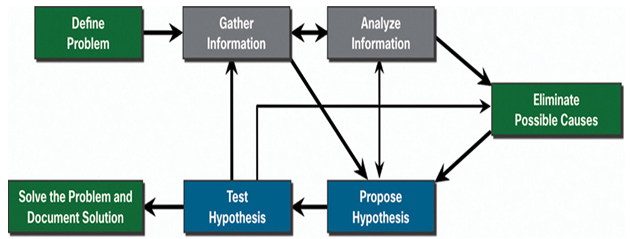Objectives
Upon completion of this chapter, you will be able to answer the following questions:
- Can you demonstrate effective troubleshooting methodologies?
- How do you create network documentation?
- What are help desk best practices?
- How do you verify network connectivity in the operating systems of Windows, Linux, MacOS, Android, and Apple iOS devices?
- How do you troubleshoot a network?
- How do you troubleshoot connectivity remotely?
Key Terms
This chapter uses the following key terms. You can find the definitions in the Glossary.
baseline
bottom-up troubleshooting
Cisco Discovery Protocol (CDP)
divide-and-conquer troubleshooting
top-down troubleshooting
Hello! It’s Webster. Let me introduce you to my friend Lara! Lara has been working as a help desk technician in the IT department for a small community college in Brisbane, Australia, for just over a year. The help desk receives numerous IT support requests from administrators, faculty, and students. Lara has proven to be an excellent asset to the help desk team, as she is very effective at solving problems. Because of her superb work, Lara was recently promoted and assigned to develop a troubleshooting guide to help new technicians solve everyday IT problems. What approach would you use when diagnosing a reported problem? What documentation would you need to help do your job? How do you keep track of a reported problem? Which commands would be helpful when diagnosing endpoint and network problems? Keep reading, as we will answer these questions in this chapter.
Diagnostics and Troubleshooting Methodologies (37.1)
In this section, you will learn about the general troubleshooting process.
Troubleshooting Process Review (37.1.1)
Troubleshooting is the process of identifying, locating, and correcting problems. This process involves gathering information and using one or more structured troubleshooting methods.
After the problem in the network is first discovered, one of the first steps is to gather information. The following list provides a review of some of the information you may wish to collect.
- Determine the nature of problem
- End-user reports
- Problem verification report
- Gather relevant equipment information
- Manufacturer
- Make/model
- Firmware version
- Operating system version
- Ownership/warranty information
- Gather configuration and topology information
- Physical and logical topology
- Configuration files
- Log files
- Determine if there were any similar issues previously
- Steps taken
- Results achieved
Seven-Step Troubleshooting Process (37.1.2)
Figure 37-1 displays a more detailed seven-step troubleshooting process. Notice how some steps interconnect. This is because some technicians may be able to jump between steps based on their level of experience.

Figure 37-1 A Seven-Step Troubleshooting Process
The goal of this stage is to verify that there is a problem and then properly define what the problem is. Problems are usually identified by a symptom (e.g., the network is slow or has stopped working). Network symptoms may appear in many different forms, including alerts from the network management system, console messages, and user complaints.
While gathering symptoms, it is important to ask questions and investigate the issue in order to localize the problem to a smaller range of possibilities. For example, is the problem restricted to a single device, a group of devices, or an entire subnet or network of devices?
In an organization, problems are typically assigned to network technicians as trouble tickets. These tickets are created using trouble ticketing software that tracks the progress of each ticket. Trouble ticketing software may also include a self-service user portal to submit tickets, access to a searchable trouble tickets knowledge base, remote control capabilities to solve end-user issues, and more.
